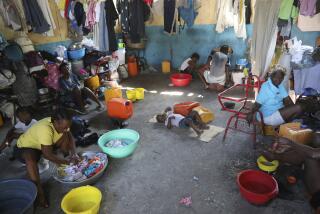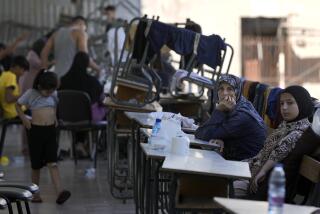In Haiti, aid workers face a dual challenge
- Share via
In Haiti, average life expectancy is 53, three-quarters of women give birth without a health attendant, diarrheal illnesses are the second-leading cause of death and 30% of children younger than 5 have stunted growth.
And that was before Tuesday’s magnitude 7.0 earthquake.
This time, emergency medical responders will have to provide much more than the usual food, water, latrines and bandages to stop the spread of disease, said Dr. Christina Catlett, associate director for health preparedness at the Johns Hopkins Office of Critical Event Preparedness and Response in Baltimore. They’ll also have to create a public health system on the fly.
It’s not clear yet whether aid workers will have enough resources to meet all needs, Catlett said. Haitians are in desperate need of clean water, and there was a stampede Thursday when a rumor spread that water was available, she said. One person needs about four gallons of clean water for drinking and hygiene per day to limit disease.
“My heart absolutely broke when I heard about [the quake],” she said. “Haiti had significant health problems prior to the earthquake: HIV, tuberculosis, severe malnutrition, intestinal parasites, anemia and a host of other problems.”
In the Western Hemisphere’s poorest nation, with a population of about 9 million, only $96 per person is spent on healthcare, compared with $6,090 in the United States and $3,040 in France. Half of all Haitian families live in a single-room dwelling. About 8% of newborns and children younger than 5 die of malnourishment each year. One-quarter of adult women are anemic. There are roughly three doctors in Haiti for every 10,000 people, according to the World Health Organization.
“This would be a disaster anywhere,” said Dr. Alina Dorian, assistant director of the UCLA Center for Public Health and Disasters. “However, when you’re starting with pretty much zero infrastructure, this really overwhelms everything.”
Haiti will challenge the record of the global public health response to natural disasters, said Dr. Georges Benjamin, executive director of the American Public Health Assn. Such responses have been generally effective, with successful efforts to curtail disease outbreaks and deaths after the Indian Ocean tsunami of 2004 and Hurricane Katrina.
“We know how to do this. That’s not an issue,” he said.
But humanitarian support systems, such as the World Health Organization and non-governmental organizations, have been crippled by the disaster. According to news reports, only one hospital in Port-au-Prince, the capital, is functioning.
Clean water is the most crucial need. Diseases such as cholera and dysentery may break out if people drink contaminated water.
But food is also more crucial than in most other disasters. Many Haitians are already underweight and won’t be able to survive as long as a healthy person without food, Dorian said. Emergency health responders may need to set up therapeutic feeding stations to care for people who are in danger of starving.
There is also the risk that people could resort to eating contaminated food, making food-borne illness likely.
“When you’re hungry, you’ll eat whatever you can find,” Benjamin said. “People may eat food that’s not safe and we’ll have water- and food-borne illnesses like E. coli and salmonella.”
If Haitians flock to shelters, which seems likely considering their limited options, crowding will increase the threat of disease. Haiti already has high rates of communicable diseases such as tuberculosis and measles.
“You have worry about hand-washing and hygiene and roaches and vermin that carry disease,” Benjamin said. “Waste disposal is so important. Anyone who has ever been on a cruise ship knows how easily a gastrointestinal illness like norovirus can spread.”
These threats are much more real than those posed by the many corpses lying in the streets, Dorian said. “Dead bodies transmit disease less than a live body,” she said.
Chronically ill Haitians are likely to be hit especially hard. The number of Haitians infected with the human immunodeficiency virus, which causes AIDS, is estimated to be at least 200,000 and it could be as high as 600,000. Haiti has about 30,000 new cases of tuberculosis each year, according to WHO. People taking daily medications for HIV or tuberculosis may be cut off from their supplies, Dorian said. Already weakened, they’ll be less able to withstand new illnesses.
Diseases such as tetanus and diphtheria -- much more common there because of low rates of childhood vaccination -- could spread easily. And people injured in the quake may be susceptible to infections, such as tetanus, sepsis and meningitis, which would be fatal if untreated.
“The baseline health conditions and health status of Haitians is going to make responding more challenging,” Catlett said. “There was no margin for error in the first place.”
The tragedy will cause an immediate deterioration of public health delivery in Haiti, but it also could focus long-term attention on the nation’s desperate medical needs.
“Haiti has gone through so much for the past decade; flood after flood and disaster after disaster and coup d’etat after coup d’etat, and the international community only responded on the surface,” said Ulrick Gaillard, chief executive of the Batey Relief Alliance, a nonprofit agency that provides assistance in Haiti. “Right now you have a country completely destroyed. The only way the international community can respond to Haiti is by rebuilding Haiti.”
More to Read
Sign up for Essential California
The most important California stories and recommendations in your inbox every morning.
You may occasionally receive promotional content from the Los Angeles Times.










